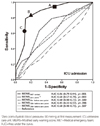1. Minino AM, Heron MP, Murphy SL, Kochanek KD. Deaths: Final data for 2004. Natl Vital Stat Rep. 2007; 55(19):1–119.
2. Angus DC, Linde-Zwirble WT, Lidicker J, Clermont G, Carcillo J, Pinsky MR. Epidemiology of severe sepsis in the United States: Analysis of incidence, outcome, and associated costs of care. Crit Care Med. 2001; 29(7):1303–1310.
3. Levy MM, Fink MP, Marshall JC, Abraham E, Angus D, Cook D, et al. 2001 SCCM/ESICM/ACCP/ATS/SIS international sepsis definitions conference. Intensive Care Med. 2003; 29(4):530–538.
http://dx.doi.org/10.1007/s00134-003-1662-x.
4. Levy MM, Dellinger RP, Townsend SR, Linde-Zwirble WT, Marshall JC, Bion J, et al. The surviving sepsis campaign: Results of an international guideline-based performance improvement program targeting severe sepsis. Intensive Care Med. 2010; 36(2):222–231.
http://dx.doi.org/10.1007/s00134-009-1738-3.
5. Esteban A, Frutos-Vivar F, Ferguson ND, Peñuelas O, Lorente JA, Gordo F, et al. Sepsis incidence and outcome: Contrasting the intensive care unit with the hospital ward. Crit Care Med. 2007; 35(5):1284–1289.
http://dx.doi.org/10.1097/01.ccm.0000260960.94300.de.
6. Goldhill DR, Worthington L, Mulcahy A, Tarling M, Sumner A. The patient-at-risk team: Identifying and managing seriously ill ward patients. Anaesthesia. 1999; 54(9):853–860.
7. Hong SK, Hong SB, Lim CM, Koh Y. The characteristics and prognostic factors of severe sepsis in patients who were admitted to a medical intensive care unit of a tertiary hospital. Korean J Crit Care Med. 2009; 24(1):28–32.
http://dx.doi.org/10.4266/kjccm.2009.24.1.28.
8. Hillman KM, Bristow PJ, Chey T, Daffurn K, Jacques T, Norman SL, et al. Duration of life-threatening antecedents prior to intensive care admission. Intensive Care Med. 2002; 28(11):1629–1634.
http://dx.doi.org/10.1007/s00134-002-1496-y.
9. Calle P, Cerro L, Valencia J, Jaimes F. Usefulness of severity scores in patients with suspected infection in the emergency department: A systematic review. J Emerg Med. 2012; 42(4):379–391.
http://dx.doi.org/10.1016/j.jemermed.2011.03.033.
10. Smith GB, Osgood VM, Crane S. ALERT-a multiprofessional training course in the care of the acutely ill adult patient. Resuscitation. 2002; 52(3):281–286.
11. Lee A, Bishop G, Hillman KM, Daffurn K. The medical emergency team. Anaesth Intensive Care. 1995; 23(2):183–186.
12. Bellomo R, Goldsmith D, Uchino S, Buckmaster J, Hart G, Opdam H, et al. Prospective controlled trial of effect of medical emergency team on postoperative morbidity and mortality rates. Crit Care Med. 2004; 32(4):916–921.
13. Subbe CP, Kruger M, Rutherford P, Gemmel L. Validation of a modified early warning score in medical admissions. QJM. 2001; 94(10):521–526.
15. Gardner-Thorpe J, Love N, Wrightson J, Walsh S, Keeling N. The value of modified early warning score (MEWS) in surgical in-patients: A prospective observational study. Ann R Coll Surg Engl. 2006; 88(6):571–575.
http://dx.doi.org/10.1308/003588406x130615.
16. Corfield AR, Lees F, Zealley I, Houston G, Dickie S, Ward K, et al. Utility of a single early warning score in patients with sepsis in the emergency department. Emerg Med J. 2013; 03. 09. Forthcoming.
http://dx.doi.org/10.1136/emermed-2012-202186.
18. Jo S, Lee JB, Jin YH, Jeong TO, Yoon JC, Jun YK, et al. Modified early warning score with rapid lactate level in critically ill medical patients: The ViEWS-L score. Emerg Med J. 2013; 30(2):123–129.
http://dx.doi.org/10.1136/emermed-2011-200760.
19. Potter PA, Perry AG. Fundamentals of nursing. 5th ed. St. Louis, MO: Mosby;2001.
20. Franklin C, Mathew J. Developing strategies to prevent inhospital cardiac arrest: Analyzing responses of physicians and nurses in the hours before the event. Crit Care Med. 1994; 22(2):244–247.
21. Harrison GA, Jacques TC, Kilborn G, McLaws ML. The prevalence of recordings of the signs of critical conditions and emergency responses in hospital wards-the SOCCER study. Resuscitation. 2005; 65(2):149–157.
http://dx.doi.org/10.1016/j.resuscitation.2004.11.017.
22. Cuthbertson BH, Boroujerdi M, McKie L, Aucott L, Prescott G. Can physiological variables and early warning scoring systems allow early recognition of the deteriorating surgical patient? Crit Care Med. 2007; 35(2):402–409.
http://dx.doi.org/10.1097/01.ccm.0000254826.10520.87.
23. Sebat F, Musthafa AA, Johnson D, Kramer AA, Shoffner D, Eliason M, et al. Effect of a rapid response system for patients in shock on time to treatment and mortality during 5 years. Crit Care Med. 2007; 35(11):2568–2575.
http://dx.doi.org/10.1097/01.ccm.0000287593.54658.89.
24. Knaus WA, Draper EA, Wagner DP, Zimmerman JE. APACHE II: A severity of disease classification system. Crit Care Med. 1985; 13(10):818–829.
26. Xinke MEN, Jing YNG, Huaxiong WU, Xiaoying ZHU, Gang WEI, Dehong LIU, et al. Comparison of modified early warning score (MEWS) and APACHE ll score in evaluation severity and prediction out-come of emergency potential severity disease. J Jiangsu Clin Med. 2005; 8:1–4.







 PDF
PDF ePub
ePub Citation
Citation Print
Print




 XML Download
XML Download